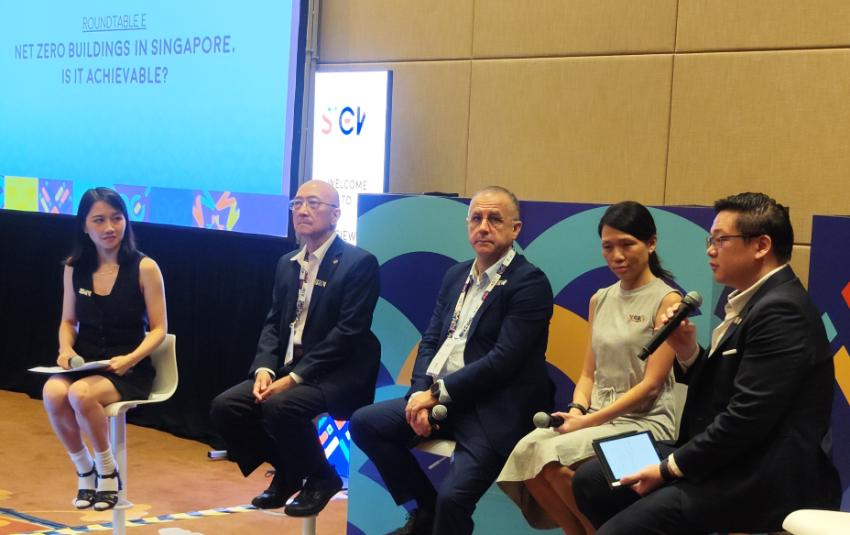As the built environment is a significant contributor to carbon emissions, coming together to develop net zero buildings has great transformative power in the transition towards a net zero world. Singapore Green Building Council (SGBC) and Singapore Institute of Technology (SIT) report.

In 2021, the Building and Construction Authority (BCA) and the Singapore Green Building Council (SGBC) launched the Singapore Green Building Masterplan, introducing three ambitious targets dubbed “80-80-80 in 2030”. These targets involve greening 80 percent of Singapore's existing buildings by 2030; ensuring 80 percent of new buildings to attain Super Low Energy status from 2030; and achieving an 80 percent improvement in energy efficiency for best-in-class green buildings by 2030.
With 55 percent of our buildings greened to date, the industry stands at a critical juncture, demanding deeper discussions and collective actions to drive the nation’s net zero aspirations forward.
In an attempt to answer the net zero question, SGBC and the Singapore Institute of Technology (SIT) hosted a SIEW Thinktank Roundtable on 27 October 2023, as part of the Singapore International Energy Week (SIEW) 2023. Themed around the feasibility of net zero buildings in Singapore, the Roundtable attracted more than 100 professionals from different industries, united by their passion and enthusiasm to explore the possibilities, challenges and solutions to achieving net zero buildings.
Moderated by Elsa Feng, Assistant Professor of Engineering at SIT, the Roundtable hosted presentations by four industry experts:
- Professor Lock Kai Sang, Head, Energy Efficiency Technology Centre, SIT
- Irene Yong, Director, Building Services, Beca
- Wang Zhenglin, Head, Marketing & Partnerships, Energy-as-a-Service, Keppel Infrastructure
- Francesco Muggeri, Vice President, Power Discrete and Analog Products, APeC & China, STMicroelectronics
The Roundtable delved into pivotal concepts encompassing building efficiency, carbon footprint reduction, net zero carbon building design, services and governance, and sustainable practices. Citing Apple's mandate for its suppliers to attain carbon neutrality, Mr Muggeri stressed the vital need for the built environment sector to replicate this initiative. Doing so could catalyse a chain reaction towards achieving carbon neutrality.
Ms Yong emphasised the challenge of convincing developers and building owners to adopt new green building technologies, as well as highlighted the potential motivations for doing so. She underscored the rising interest of businesses in leasing certified green building spaces, compelling building owners to embrace green building solutions to meet this growing demand.
Bridging academia and industry, Prof Lock stressed the importance of fostering greater collaboration. Beyond generating and disseminating information, he advocated for academia and industry to work together in experimenting and troubleshooting issues that may arise from the integration of new technologies to drive net zero buildings. Mr Muggeri also highlighted that collaboration ensures green building technologies are relevant, user-friendly, and robust.
In terms of facilitating technology adoption, Mr Wang outlined Keppel's support in providing vendors and solution providers the space to test out new technologies, pushing successful outcomes to market. Beyond this, Keppel encourages other green building owners to adopt proven solutions and consider offsite solutions when greening their buildings.
Ms Yong emphasised that importance of tailored solutions, stressing that not every piece of new state-of-the-art technology will work for every building. She added that both the hard and soft infrastructure need to be properly designed and implemented for the new solutions to be effective.
The net zero question for the built environment is not an easy one to answer, but the Roundtable surfaced multifaceted considerations. These ranged from cost considerations to the importance of third-party certification, and the need for a motivational “spark” to accelerate sustainability initiatives and outcomes. However, the resounding takeaway here was the need to meaningfully activate diverse stakeholders, fostering greater collaboration to move the needle on sustainability in the built environment.
With the world’s attention focused on sustainability, net zero buildings can be a force multiplier in propelling us towards a greener, low carbon world.